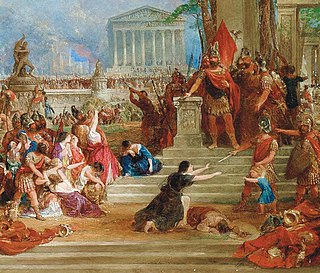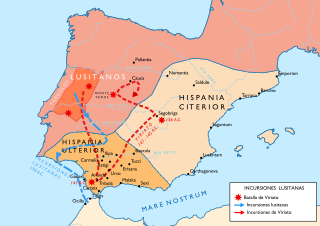Events
The battle
After succeeding Mummius, Marcus Atilius made an incursion among the Lusitanians and killed about 700 of them and took their largest city, called Oxthracae. This terrified the neighboring tribes (including the Vettones) into offering their surrender. [1]
Aftermath
The conquest of Oxthracae terrified the surrounding tribes, including the Vettones, who immediately sought terms of surrender, temporarily securing Roman dominance in the region, however, once Atilius withdrew his forces to winter quarters, the Lusitanians revolted and besieged some of Rome's allied settlements. [1]

Lucius Mummius was a Roman statesman and general. He was consul in the year 146 BC along with Gnaeus Cornelius Lentulus.

The gens Atilia, sometimes written Atillia, was a plebeian family at ancient Rome, which rose to prominence at the beginning of the fourth century BC. The first member of this gens to attain the consulship was Marcus Atilius Regulus, in 335 BC. The Atilii continued to hold the highest offices of the state throughout the history of the Republic, and well into imperial times.
Lucius Licinius Lucullus was a Roman politician who became consul in 151 BC.

Viriathus was the most important leader of the Lusitanian people that resisted Roman expansion into the regions of western Hispania or western Iberia, where the Roman province of Lusitania would be finally established after the conquest.
The Lusitanians were an Indo-European-speaking people living in the far west of the Iberian Peninsula, in present-day central Portugal and Extremadura and Castilla y Leon of Spain. After its conquest by the Romans, the land was subsequently incorporated as a Roman province named after them (Lusitania).

Conistorgis was the main city of the Conii or Cynetes. In the Conii language it probably meant "city of the Conii". The Celtici seem to have been present there.
This is a historical timeline of Portugal.
Servius Sulpicius Galba was a consul of Rome in 144 BC.

The Roman Republic conquered and occupied territories in the Iberian Peninsula that were previously under the control of native Celtic, Iberian, Celtiberian and Aquitanian tribes and the Carthaginian Empire. The Carthaginian territories in the south and east of the peninsula were conquered in 206 BC during the Second Punic War. Control was gradually extended over most of the peninsula without annexations. It was completed after the end of the Roman Republic, by Augustus, the first Roman emperor, who annexed the whole of the peninsula to the Roman Empire in 19 BC.

The Numantine War was the last conflict of the Celtiberian Wars fought by the Romans to subdue those people along the Ebro. It was a twenty-year conflict between the Celtiberian tribes of Hispania Citerior and the Roman government. It began in 154 BC as a revolt of the Celtiberians of Numantia on the Douro. The first phase of the war ended in 151, but in 143, war flared up again with a new insurrection in Numantia.
The Second Celtiberian War was one of the three major rebellions by the Celtiberians against the presence of the Romans in Hispania.
The First Celtiberian War and Second Celtiberian War were two of the three major rebellions by the Celtiberians against the presence of the Romans in Hispania.
The First Celtiberian War was the first of three major rebellions by the Celtiberians against the Roman presence in Hispania. The other two were the Second Celtiberian War and the Numantine War. Hispania was the name the Romans gave to the Iberian Peninsula. The peninsula was inhabited by various ethnic groups and numerous tribes. The Celtiberians were a confederation of five tribes, which lived in a large area of east central Hispania, to the west of Hispania Citerior. The eastern part of their territory shared a stretch of the border of this Roman province. The Celtiberian tribes were the Pellendones, the Arevaci, the Lusones, the Titti and the Belli.

The Lusitanian Wars, called Pyrinos Polemos in Greek, were wars of resistance fought by the Lusitanian tribes of Hispania Ulterior against the advancing legions of the Roman Republic from 155 to 139 BC. The Lusitanians revolted in 155 BC, and again in 146 BC and were pacified. In 154 BC, a long war in Hispania Citerior, known as the Numantine War, was begun by the Celtiberians. It lasted until 133 and is an important event in the integration of what would become Portugal into the Roman and Latin-speaking world.
This section of the timeline of Hispania concerns Spanish and Portuguese history events from the Carthaginian conquests to before the barbarian invasions.
Tautalus was a chieftain of the Lusitanians, a proto-Celtic tribe from western Hispania. He succeeded Viriathus in the final year of the Lusitanian War.

The Conquest of Conistorgis was a military conflict between the Lusitanians and the Roman Republic.
The siege of Ocile was a military conflict between the Lusitanians and the Roman Republic.
The siege of the Blastophoenicians was a military conflict between the Lusitani-Vetonne forces and the Roman Republic.

The Battle of the Tagus was a military conflict between the Lusitanians and the Roman Republic.
This page is based on this
Wikipedia article Text is available under the
CC BY-SA 4.0 license; additional terms may apply.
Images, videos and audio are available under their respective licenses.







